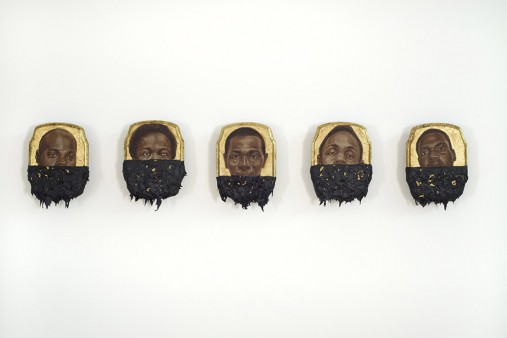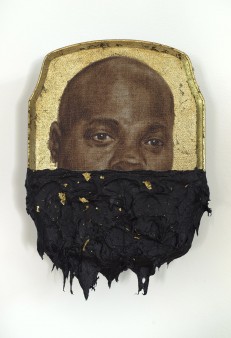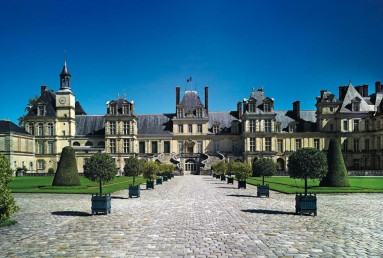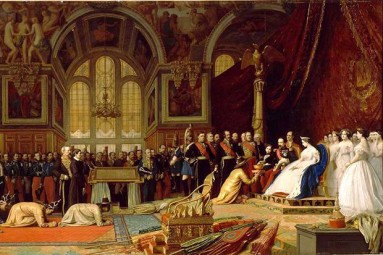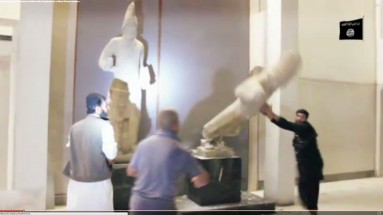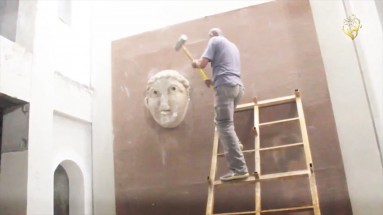In 2011, Kaphar began searching for his father’s prison records. When he visited a website containing photographs of people who have recently been arrested, he found dozens of men who shared his father’s first name, Jerome, and last name. The artist was influenced by the writings of Michelle Alexander and William Julius Wilson on the prison-industrial complex and the use of policing and imprisonment by the US government as a means to address economic, social and political problems. The panels are based on police portraits of the men named Jerome that Kaphar found online, which represent only a portion of each man’s identity yet are preserved in the public record. Although each work depicts an individual, this series represents a community of people, particularly African American men, who are overrepresented in the prison population.
After completing the portraits, Kaphar submerged a portion of each panel in tar; initially the tar-covered area corresponded to the percentage of his life that each subject had spent in prison. Kaphar abandoned the formula after considering the countless consequences of imprisonment for the men’s lives, even after their release. In his later panels, Kaphar began with his original equation and extended the tar at least up to the mouth, representing the silencing of the incarcerated men, who were stripped of many rights, including the right to vote and access to federally funded programs in many states. The tar also serves to obscure the men’s faces and provides a kind of privacy not afforded to them on the mug shot websites, which are part of the public record.
(via)
• • •
Yves Bouvier, who runs a major international art shipping and storage business, remained in police custody on Thursday after a judge ruled that he could be detained for further questioning following his arrest in Monaco on Wednesday. Two other people – a couple resident in Monaco – were also being questioned.
The Monaco attorney general, Jean-Pierre Dréno, told the Guardian that three Swiss nationals had been arrested as part of an inquiry into suspected “fraud relating to works of art”.
The amount of money allegedly defrauded through the suspected overpricing of artworks was not specified and it was unclear how many wealthy international collectors might have been affected.
The investigation is believed to centre on inflating prices in very big art transactions in which Bouvier was an intermediary. One family among the alleged victims was that of Dmitry Rybolovlev, the 48-year-old Russian magnate who owns Monaco football club.
Rybolovlev, who made his fortune in potassium mining and fertilisers, has a family art collection that is thought to be worth up to $1bn (£650m) and includes works by Monet, Picasso, Van Gogh and Gauguin.
Ranked 156th on the Forbes billionaires list, Rybolovlev has a net worth of £5.5bn. Tetiana Bersheda, a lawyer for the Rybolovlev family, confirmed that police in Monaco had launched an investigation into Bouvier, who she called “one of the most famous people in the world of art”.
(via)
• • •
A replica crown of the King of Siam given to France's emperor in the mid-19th century was among 15 “priceless” pieces of art stolen from a Chinese museum, French cultural officials said.
The Culture Ministry says the break-in before dawn Sunday at the Chinese Museum at Chateau de Fontainebleau was over in less than seven minutes. Police are investigating.
The ministry said the stolen objects were assembled by Empress Eugenie, the wife of French Emperor Napoleon III. On the ground floor of the Gros Pavilion, she built a small museum containing gifts from the King of Siam in 1861 and works of art taken during the pillage of the Summer Palace in Beijing.
King Rama IV sent a delegation to France, hoping to stave off the European country's desire for colonisation. The ambassadors in 1861 presented Napoleon III with a replica of the royal crown and two royal palanquins, one designed for a king and the other, with curtains, for a queen.
(via)
• • •
It looks terrible - vandals of the Islamic State attacking ancient Assyrian statues with sledge-hammers.
Nineveh, on the site of modern day Mosul, was the capital of the Assyrian empire that lasted nineteen centuries from 2500 to 605 BC.
But, according to archaeologists, most if not all the statues in the Mosul museum are replicas not originals. The reason they crumble so easily is that they're made of plaster.
"You can see iron bars inside," pointed out Mark Altaweel of the Institute of Archaeology at University College, London, as we watched the video together. "The originals don't have iron bars."
(via)
